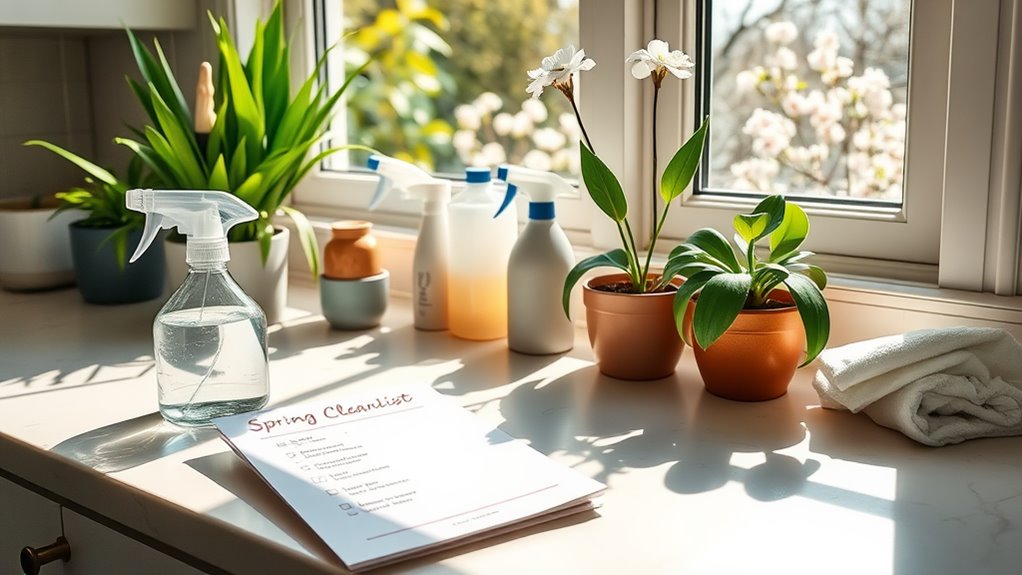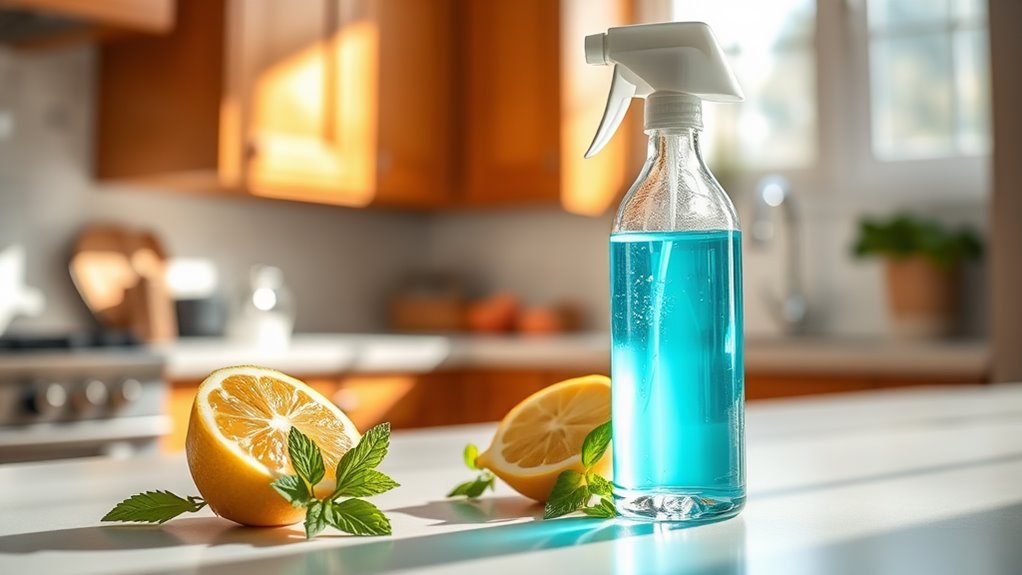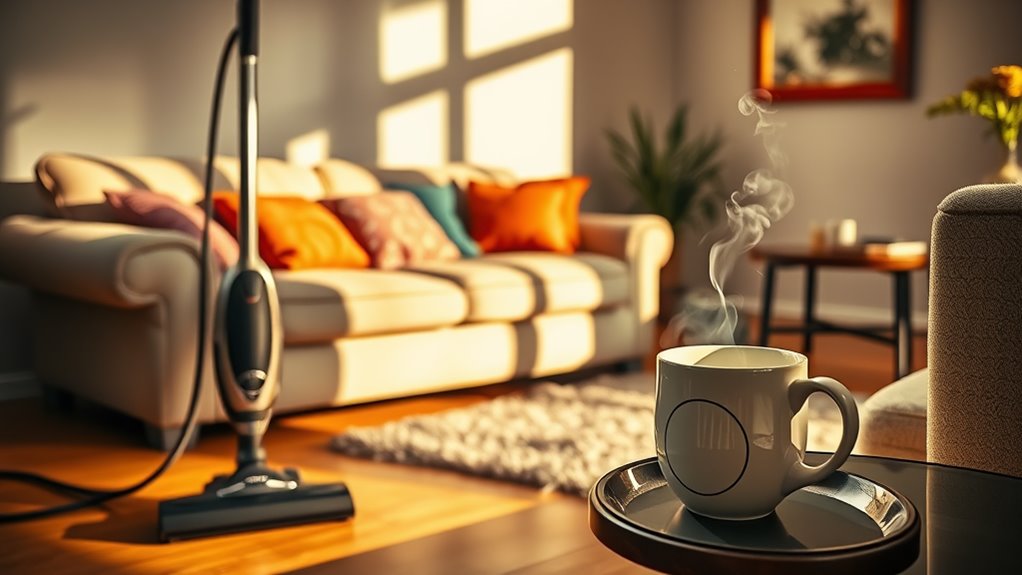This Seasonal Cleaning Checklist Will Change How You Prep for Spring
This seasonal cleaning checklist isn’t just about dusting and scrubbing; it’s a chance to revitalize your space and mindset for spring. By prioritizing tasks and creating a structured schedule, you’ll streamline your efforts and make the process manageable. Focus on decluttering, deep cleaning high-use areas like the kitchen and bathroom, and renewing your outdoor spaces. You’ll also discover eco-friendly cleaning hacks that benefit both your home and the planet. Learn how to keep your space tidy all year long!
Key Takeaways
- Create a structured cleaning schedule, prioritizing high-traffic areas and setting realistic timelines to avoid overwhelm during spring cleaning.
- Utilize the “Four-Box Method” to efficiently declutter each room, categorizing items to keep, donate, trash, or relocate.
- Deep clean specific areas, focusing on kitchens and bathrooms, to eliminate grime and refresh your living space for the season.
- Incorporate sustainable cleaning practices, using eco-friendly products like vinegar and baking soda to maintain a clean home and protect the environment.
- Celebrate progress by tracking accomplishments and maintaining a clutter-free environment through regular revisits of cleaned spaces.
Understanding the Importance of Seasonal Cleaning
When you consider the impact of seasonal cleaning, it’s clear that this practice goes beyond mere tidiness.
Spring cleaning, for instance, revitalizes your living space and enhances your mental clarity. By dedicating time to deep clean, you eliminate accumulated clutter and dust, creating an environment that promotes both productivity and relaxation. This intentional effort serves as a reset, allowing you to reassess your belongings and prioritize what truly matters. Additionally, following a weekly deep cleaning routine can make these seasonal tasks more manageable and less overwhelming. Incorporating a comprehensive guide can also help you stay organized and focused during the process. An effective approach to seasonal cleaning includes seasonal checklists that ensure all areas are addressed systematically.
Engaging in seasonal cleaning establishes a routine, fostering discipline and a sense of accomplishment. It’s not just about aesthetics; it’s about cultivating a sanctuary that reflects your values and aspirations. Embracing this practice can transform your space and, ultimately, your mindset. Furthermore, implementing a comprehensive room-by-room checklist facilitates a structured approach to tackle these tasks effectively. Regularly practicing deep cleaning techniques can enhance the efficiency and effectiveness of your cleaning efforts.
Creating a Cleaning Schedule
Creating a cleaning schedule starts with figuring out your priorities. You’ll want to set realistic timelines for each task and allocate specific chores to keep things manageable. By implementing a structured weekly cleaning schedule, you can efficiently tackle household tasks without feeling overwhelmed. Establishing a habit formation technique can further enhance your ability to stick to this schedule and make cleaning a seamless part of your routine. Incorporating efficient cleaning techniques can also help you maximize your productivity during each cleaning session. Additionally, using time-saving methods can further streamline your efforts and allow you to complete tasks more quickly. One effective strategy is to incorporate a strategic 15-minute daily cleaning routine, which can simplify your cleaning process and help maintain a consistently tidy home.
Determine Your Priorities
How can you effectively tackle your cleaning tasks? Start by identifying what matters most to you.
Take a moment to list the areas in your home that need attention, from the kitchen to the garage. Prioritize based on factors like usage and visibility—focus on high-traffic areas first.
Consider seasonal factors, too; if your windows haven’t been cleaned in ages, they might climb the list.
Once you’ve outlined your priorities, think about how each task aligns with your overall goals. Are you aiming for a clutter-free space or a deep-cleaned home?
Set Realistic Timelines
With your priorities in hand, it’s time to set realistic timelines for your cleaning tasks. Break down your list into manageable segments. Instead of tackling everything in one day, allocate specific time slots throughout the week.
Factor in your daily commitments and energy levels, so you don’t overwhelm yourself. Aim for consistency over intensity; it’s better to clean a little each day than to burn out in one marathon session. Use a calendar or planner to track your progress, adjusting timelines as necessary.
Celebrate small victories, and don’t hesitate to refine your schedule based on what works best for you. By creating a balanced approach, you’ll not only maintain motivation but also achieve mastery in your seasonal cleaning routine.
Allocate Specific Tasks
To effectively allocate specific tasks in your cleaning schedule, start by categorizing areas that need attention. Break your home into sections: living room, kitchen, bathrooms, and bedrooms.
Next, list tasks for each area, focusing on both high-impact and detailed jobs. For instance, dusting and vacuuming might be essentials, while organizing cabinets could be more detailed.
Assign a specific day or time to tackle each segment, ensuring you’re not overwhelmed. Consider your energy levels and availability; perhaps you’ll clean the kitchen after a quick breakfast.
Finally, hold yourself accountable—track your progress and adjust as needed. With a well-defined schedule, you’ll master the art of seasonal cleaning, making the process efficient and satisfying.
Decluttering Each Room
As you plunge into decluttering each room, you’ll find it easier to create a more organized and inviting space. Start with one room at a time; focus on surfaces, closets, and drawers.
Use the “Four-Box Method” to categorize items: keep, donate, trash, and relocate. Be ruthless—if you haven’t used something in the past year, it’s time to let it go. Consider the emotional weight of each item; if it no longer serves you, release it. To aid in this process, ask yourself essential self-reflection questions that help clarify your attachments and priorities. Implementing the 10-minute declutter challenge can provide a quick and effective way to kickstart your decluttering efforts. Additionally, remember that quick decluttering techniques can maximize your efficiency and impact during this process. Using natural cleaning products can also help maintain your home’s cleanliness as you declutter.
Once you’ve cleared the clutter, implement storage solutions that enhance accessibility and visibility. Label bins and shelves to maintain order. By incorporating the 5-bin sorting system, you can further streamline your decluttering process and ensure a more systematic approach.
With each room you tackle, you’ll cultivate an environment that not only looks good but also promotes clarity and peace of mind.
Deep Cleaning the Kitchen
A sparkling kitchen is the heart of a home, and deep cleaning it can transform your cooking space into a welcoming hub.
Start by emptying your cabinets and wiping them down, ensuring you tackle the corners where dust gathers. Next, scrub your countertops with a reliable disinfectant, removing any stubborn stains.
Don’t forget to clean your appliances—inside and out—paying special attention to the oven and refrigerator. Organize your pantry, tossing expired items, and wiping down shelves.
Finally, mop the floor to eliminate hidden grime. This meticulous approach not only enhances your kitchen’s appeal but also creates a healthier cooking environment.
Embrace this deep clean, and you’ll find joy in preparing meals within your refreshed space.
Refreshing the Bathroom
Revitalizing your bathroom can make a world of difference in your daily routine.
Start by decluttering surfaces—remove items you don’t use often and organize essentials neatly.
Next, tackle those surfaces with a powerful cleaner; focus on countertops, sinks, and faucets, ensuring they shine.
Don’t neglect the toilet; a thorough scrub and disinfecting will elevate hygiene.
Refresh your shower by removing soap scum, and consider replacing any worn-out shower curtains or liners.
Finally, pay attention to the air—replace or clean your exhaust fan and add a scented candle or diffuser for a pleasant ambiance.
Reviving Living Spaces
When it comes to reviving your living spaces, start by decluttering and organizing everything.
A clean and tidy environment can instantly boost your mood and make your home feel more welcoming.
Don’t forget to deep clean your upholstery items; they can collect dust and stains that detract from your space’s overall appeal.
Declutter and Organize Spaces
While you might feel overwhelmed by clutter, tackling each space step-by-step can transform your home into a sanctuary.
Begin by setting aside dedicated time for decluttering; choose one room or area at a time. Assess each item: keep what serves a purpose or brings joy, and let go of the rest.
Use storage solutions that fit your style—baskets, bins, or shelves—to create a functional and visually appealing layout. Label containers for easy access, and maintain a consistent organization system.
Remember, the goal is to create a harmonious environment that reflects your values and lifestyle. Regularly revisit your spaces to guarantee they remain clutter-free.
With these strategies, you’ll master the art of organization, paving the way for a serene living space.
Deep Clean Upholstery Items
To truly refresh your living spaces, deep cleaning upholstery items is essential.
Start by vacuuming thoroughly to remove dust and debris. Next, treat stains with an appropriate cleaner; blot rather than rub to avoid damage.
For fabrics that tolerate water, a mixture of mild detergent and water can work wonders—test it on a hidden area first. Use a soft brush to gently scrub, then wipe with a damp cloth.
For leather, a specialized cleaner and conditioner will restore its luster.
Finally, consider a fabric protector to guard against future stains.
Tending to Outdoor Areas
As spring rolls in, it’s essential to give your outdoor spaces some much-needed attention.
You’ll create a welcoming environment and set the tone for outdoor gatherings. Start by tackling these important tasks:
-
Clear Debris: Remove fallen leaves, branches, and any clutter from your yard and patio. This not only improves aesthetics but also prevents pests.
-
Inspect Hardscapes: Check walkways, patios, and decks for cracks or damage. Repairing these surfaces guarantees safety and prolongs their lifespan.
-
Refresh Plant Beds: Trim back perennials, remove weeds, and add fresh mulch. This revitalizes your garden and promotes healthy growth.
Organizing Storage Spaces
A well-organized storage space can make a significant difference in your home’s functionality.
Start by evaluating what you have; declutter items you no longer need. Group similar items together to streamline your storage solutions. Use clear bins to store smaller items, labeling each container for easy identification.
Consider vertical space—install shelves or hooks to maximize storage areas. Utilize drawer organizers to keep tools or utensils tidy.
Don’t forget about seasonal items; rotate them based on usage, ensuring you access frequently used items easily. Regularly revisit your storage spaces, maintaining order and functionality.
Sustainable Cleaning Products to Use
While many conventional cleaning products contain harsh chemicals that can harm the environment, sustainable cleaning products offer a safer alternative for both your home and the planet.
By choosing these eco-friendly options, you’ll not only keep your space clean but also contribute to a healthier ecosystem.
Here are three sustainable cleaning products you should consider:
-
Vinegar: A powerful natural disinfectant, it cuts through grease and eliminates odors.
-
Baking Soda: This versatile ingredient acts as a gentle abrasive, perfect for scrubbing surfaces and deodorizing.
-
Castile Soap: Made from vegetable oils, it’s biodegradable and effective for various cleaning tasks, from floors to dishes.
Embrace these products, and you’ll master the art of sustainable cleaning while protecting our planet for future generations.
Maintaining a Clean Home Throughout the Year
To maintain a clean home throughout the year, you need a consistent routine that makes tidying up manageable.
Establish daily habits, like making your bed and doing dishes right after meals. Schedule weekly deep cleans for specific areas—focus on dusting, vacuuming, and bathroom scrubbing.
Create a monthly checklist for tasks like decluttering closets or organizing the garage. Don’t forget seasonal touches—rotate your cleaning products and refresh linens.
Implement a “one in, one out” rule to keep clutter at bay. Involve your family by assigning age-appropriate tasks, fostering teamwork.
Finally, be adaptable; life changes, and so should your routine. With commitment and discipline, you’ll master the art of maintaining a clean and organized home year-round.
Frequently Asked Questions
What Tools Are Essential for an Effective Spring Cleaning?
For effective spring cleaning, you’ll need a vacuum, microfiber cloths, a mop, all-purpose cleaner, a broom, scrub brushes, and garbage bags. These tools’ll help you tackle dirt and clutter, ensuring a thorough and satisfying clean.
How Can I Involve My Family in the Cleaning Process?
To involve your family in the cleaning process, set clear tasks for everyone, create a fun competition, and reward efforts. When everyone participates, you’ll not only finish faster but also strengthen your bond together.
What Are Some Tips for Cleaning Hard-To-Reach Areas?
To tackle hard-to-reach areas, use extendable tools like dusters or vacuum attachments. Incorporate a sturdy ladder for high spots, and don’t forget to move furniture for thorough cleaning. Regularly inspect these areas to maintain cleanliness.
How Do I Manage Seasonal Allergies During Cleaning?
To manage seasonal allergies while cleaning, wear a mask, use a vacuum with a HEPA filter, and keep windows closed. Dust regularly and consider using air purifiers to reduce allergens in your environment.
Can I Clean My Carpets Without Hiring Professionals?
Yes, you can clean your carpets without hiring professionals. Invest in a quality carpet cleaner, use appropriate cleaning solutions, and follow manufacturer instructions. Regular maintenance will keep your carpets looking great and extend their lifespan.



